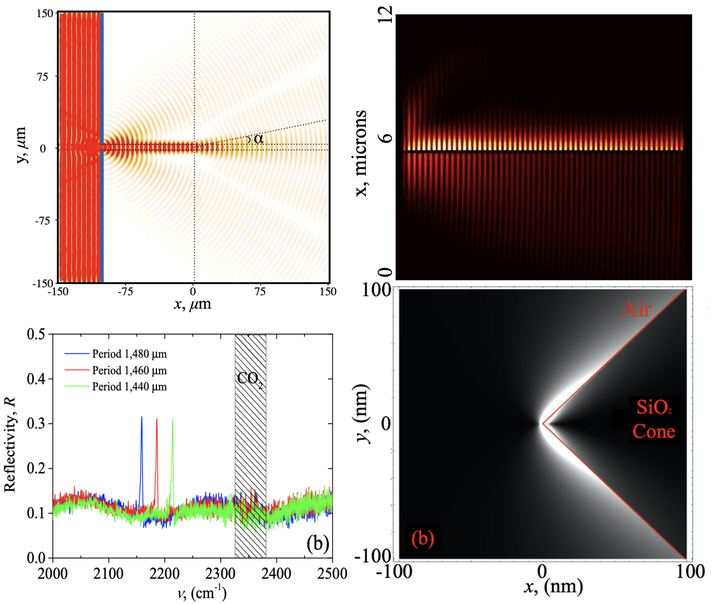Thermal energy manipulation via electromagnetic surface waves at micro and nanoscales

Abstract
Many modern industrial applications require precise control of heat when the sizes of the objects are in the order of hundreds of nanometers. There are numerous different approaches recently proposed which could help to tune the thermal properties of nanostructured materials by using phononic crystals, phonon superlattices, thin layered structures, graphene based structures, and Surface Phonon Polaritons (SPhPs). The latter are electromagnetic surface waves that are coupled with transverse optical phonons of the materials. These surface waves propagate along an interface of two optically active dielectrics and are usually observed for mid-infrared frequencies around 10 μm (that corresponds to the wavelength of maximal thermal emission for a block body at ambient temperature). The important property of these modes is that they can have a very large local density of states and can carry heat energy along the interface. These properties together with the fact that they can have a spatial coherence length of several wavelengths make them potential candidates for various applications in both enhancing the thermal conductivity of the materials and providing coherent thermal near-field radiation close to the interfaces. These surface modes have attracted significant attention during the last decade due to the fact that these effects can be achieved for cheap nontoxic materials frequently used in nano-fabrication (e.g. SiO2, SiC, BN, VO). However, industrial applications remain challenging as these modes can only be excited in a very narrow frequency range that is limited by the materials used and as their propagation length is not long enough. In this work, we demonstrate that by modifying the geometry of the interfaces we can significantly increase the performance of these surface modes for thermal applications. We consider amorphous glass as it is the most common dielectric used in nano-fabrication and demonstrate various effects through theory, numerical simulations, and experiments. Our work consists of five main parts. The fist part is a short introduction to the concept of SPhPs and some modern applications of these modes in heat transfer. The second part consists of three chapters where we study focusing of thermal energy of SPhPs with conical and wedge structures, respectively, as well as superfocalisation of infrared light in far field. The idea of SPhP focusing is based on the tip effect. We perform an optimization of the cone and wedge aperture angles theoretically and study the frequency dependence of the focusing efficiency. In the superfocalisation chapter, we propose an optical system based on two thin parallel membranes supporting long-range surface modes that can significantly reduce the diffraction angles of sub-wavelength apertures. We perform a numerical study for thin amorphous glass membranes and compare the obtained diffraction angles of this new optical system with diffraction on an infinite slit of the same size. We also perform a parametric study of this system. The results obtained in this part will be potentially interesting for infrared near-field microscopy, nanoscale heat extraction devices, and mid-infrared optics. In the third part of our work, we perform a detailed study of all possible long-range surface modes that can be supported by a plane interface between two dielectrics and by a thin dielectric film symmetrically surrounded by the air. We demonstrate that thin films can support not only SPhPs but also Zenneck and TM-guided thermally excited long-range surface modes theoretically, numerically, and experimentally. We also demonstrate that thin amorphous glass membranes produce coherent thermal radiation almost over the entire infrared spectrum and we experimentally measure the dispersion relation of long-range surface modes in such structure as well as their spatial coherence length. Based on our experimental results, we estimate the contribution of this long-range surface modes to the thermal conductivity of thin films to be more than one order of magnitude larger than the one of phonons. These outcomes are of possible interest for anyone working on surface waves as well as for the nanoscale heat transfer community and near-field radiation community. The fourth and the last part shows the results of an ANR collaboration with our partners in designing a tuneable Quantum Cascade Laser (QCL). We performed infrared optical characterization of very resonant infrared mirrors designed to reflect the output of the QCL. We developed an experimental methodology of infrared characterization of micro-size optical devices in reflectivity regime as well as infrared mapping of the spectral reflectivity for small incidence angles. This part of the work should be useful for the far-field infrared spectral microscopy community and for those interested in QCLs.